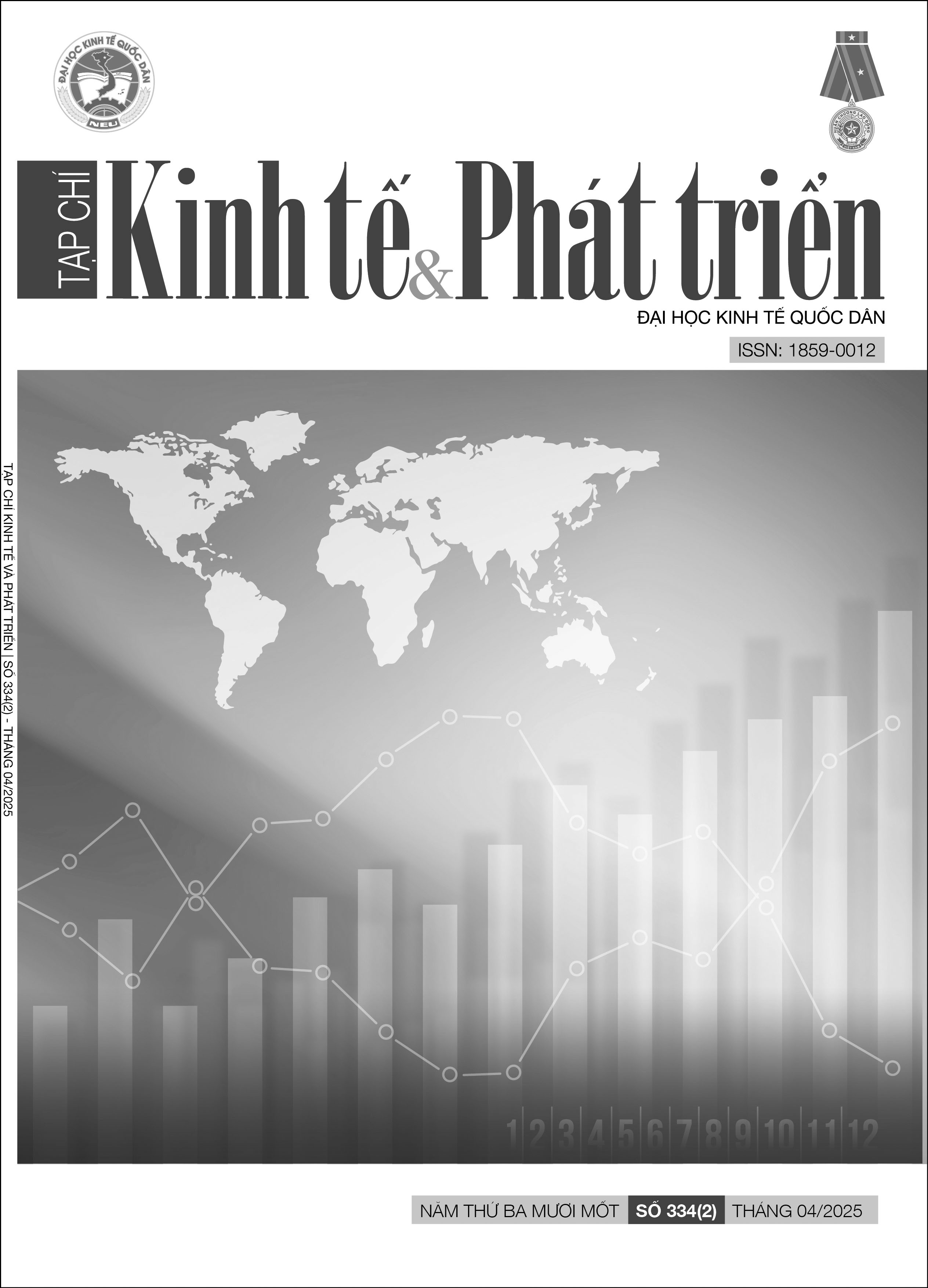Tác động của các yếu tố tài chính, du lịch và thương mại đến lãi suất tiền gửi: Nghiên cứu thực nghiệm tại một số quốc gia châu Á
DOI:
https://doi.org/10.33301/JED.VI.2262Từ khóa:
Du lịch, lãi suất, tài chính, thương mại, tiền gửiTóm tắt
Nghiên cứu này phân tích tác động của một số yếu tố tài chính, du lịch và thương mại đến lãi suất tiền gửi tại bảy quốc gia châu Á trong giai đoạn 2004–2023, bao gồm: Trung Quốc, Nhật Bản, Việt Nam, Thái Lan, Pakistan, Iraq và Uzbekistan. Dữ liệu được xử lý bằng các phương pháp hồi quy Pooled OLS, FEM, REM và FGLS. Kết quả từ mô hình FGLS cho thấy tín dụng trong nước cho khu vực tư nhân có tác động tiêu cực và có ý nghĩa thống kê đến lãi suất tiền gửi. Bên cạnh đó, số lượng doanh nghiệp mới đăng ký cho thấy tác động tích cực, lượng khách du lịch quốc tế cho thấy tác động tiêu cực ở mức ý nghĩa gần 10%. Yếu tố còn lại như chi nhánh ngân hàng chưa cho thấy tác động đáng kể. Nghiên cứu gợi ý rằng việc mở rộng tín dụng tư nhân có thể giúp giảm chi phí huy động vốn, đồng thời cần đánh giá thận trọng vai trò của các yếu tố thương mại và du lịch trong điều hành lãi suất.
Tài liệu tham khảo
Boungou, W. (2022), ‘“Negative-for-long” interest rates and customer deposit rate’, Finance Research Letters, 46, 102298.
Cevik, S., & Charap, J. (2015), ‘The behavior of conventional and Islamic bank deposit returns in Malaysia and Turkey’, International Journal of Economics and Financial Issues, 5(1), 111-124.
Chernykh, L., & Kotomin, V. (2022), ‘Risk-based deposit insurance, deposit rates and bank failures: Evidence from Russia’, Journal of Banking & Finance, 138, 106483.
Demiralp, S., Eisenschmidt, J., & Vlassopoulos, T. (2021), ‘Negative interest rates, excess liquidity and retail deposits: Banks’ reaction to unconventional monetary policy in the euro area’, European Economic Review, 136, 103745.
Dogdu, A., & Kayacan, M. (2024), ‘Instruments and effects of monetary and fiscal policy: The relationship between inflation, VAT, and deposit interest rate’, Working paper, available on arXiv preprint arXiv:2404.03989.
Filipiak, B. Z., Dylewski, M., & Kalinowski, M. (2023), ‘Economic development trends in the EU tourism industry. Towards the digitalization process and sustainability’, Quality & Quantity, 57(Suppl 3), 321-346.
Firdaus, M. A. (2023), ‘The influence of customer’s perception regarding the idic and deposit interest rate on the customer interest in saving at digital bank pt. neo commerce bank tbk. period 2021-2022’, Doctoral Dissertation, President uUniversity.
Friedman, M. (1956), ‘The quantity theory of money: A restatement’, In M. Friedman (Ed.), Studies in the quantity theory of money (pp. 3–21), University of Chicago Press.
Haerinasab, Z., Sohaili, K., & Fattahi, S. (2018), ‘Investigating the Relationship between the Facility Interest Rate and the Bank Deposit Interest Rate in Iran’, Advances in Mathematical Finance and Applications, 3(4), 53-66.
Hailiang, Z., Chau, K. Y., & Waqas, M. (2023), ‘Does green finance and renewable energy promote tourism for sustainable development: empirical evidence from China’, Renewable Energy, 207, 660-671.
Jacewitz, S., & Pogach, J. (2018), ‘Deposit rate advantages at the largest banks’, Journal of Financial Services Research, 53, 1-35.
Mansour, M., Sghaier, A., Bannour, B., & Ben Jabeur, S. (2019), ‘The interactions between the lending rates, deposit rates and money market rates’, Iranian Economic Review, 23(1), 163-189.
Messer, T., & Niepmann, F. (2023), ‘What determines passthrough of policy rates to deposit rates in the euro area?’, European Central Bank (ECB) Working Paper Series No. 2835.
Mishkin, F. S. (2016), The economics of money, banking, and financial markets (10th ed.), Pearson Education.
Modigliani, F., & Brumberg, R. H. (1954), ‘Utility analysis and the consumption function: An interpretation of cross-section data’, In K. K. Kurihara (Ed.), Post-Keynesian economics (pp. 388–436), New Brunswick, NJ: Rutgers University Press.
Pădurean, M. A., Nica, A. M., & Nistoreanu, P. (2015), ‘Entrepreneurship in tourism and financing through the Regional Operational Programme’, Amfiteatru Economic Journal, 17(38), 180-194.
Pardiman, P., Susyanti, J., Heriyawati, D. F., Zakaria, Z., & Masyhuri, M. (2022), ‘Impact of financial capital, social capital, and business digitalization on business sustainability of SMEs in Indonesia’, Jurnal Manajemen Dan Pemasaran Jasa, 15(1), 69-82.
Purba, M., Simanjutak, D., Malau, Y., Sholihat, W., & Ahmadi, E. (2021), ‘The effect of digital marketing and e-commerce on financial performance and business sustaina-bility of MSMEs during COVID-19 pandemic in Indonesia’, International Journal of Data and Network Science, 5(3), 275-282.
Tang, Y. M., Chau, K. Y., Hong, L., Ip, Y. K., & Yan, W. (2021), ‘Financial innovation in digital payment with WeChat towards electronic business success’, Journal of Theoretical and Applied Electronic Commerce Research, 16(5), 1844-1861.





